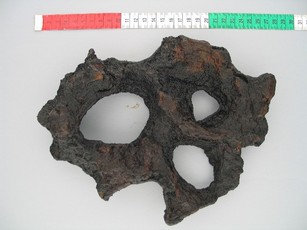Nov 3 2007
Researchers at the University of Massachusetts Amherst have discovered metal-rich sedimentary deposits in a New Hampshire lake that grow faster than any other deposits found in the United States. Understanding the environmental conditions that aid in the creation of the structures, which contain copper, iron and other heavy metals, could be helpful in discovering new metal sources.
The findings, which are reported in this week’s issue of the Proceedings of the National Academy of Sciences, are a part of the dissertation work of Celeste Asikainen, a doctoral student of Lynn Margulis in the department of geosciences. Sean Werle, an adjunct professor in biology and a curator at the UMass Natural History Museum, discovered the deposits, called nodules, while diving in Second Connecticut Lake, 40 miles north of Berlin, N.H. and four miles south of the Canadian border, in 2002. Asikainen then went back to the lake to collect samples of the nodules and analyze them in her laboratory.
 A "lattice-like" ferromanganese nodule, one of four different shapes of the deposits found in Second Connecticut Lake.
A "lattice-like" ferromanganese nodule, one of four different shapes of the deposits found in Second Connecticut Lake.
Known as ferromanganese nodules for their abundance of iron and manganese, the deposits can also contain other elements such as copper, nickel and cobalt. Although nodules of this kind have been collected in large amounts from deep-sea deposits, freshwater nodules such as those Asikainen studies could provide a more easily accessible supply of these metals. Understanding the chemistry of these waters may help scientists know what to look for when discovering new heavy metal sources. Additionally, knowledge of the conditions under which these deposits grow can inform efforts to prepare waters impacted by these heavy metals for drinking by the general public.
“We want to know why they grow where they grow,” said Asikainen, who noted that the nodules can be found in a variety of environments, such as fresh and salt water and even in soils. “If we can understand the geological conditions of their growth, we could predict where nodules occur.”
One problem that geologists who study metal formations face is determining how old the deposits are. Since the nodules do not contain carbon-based compounds, the widely used geological technique of radiocarbon dating cannot provide data. Asikainen and Werle made the serendipitous discovery, however, of a glass bottle from the year.
1929 at the bottom of Second Connecticut Lake. The bottle had ferromanganese deposits growing on it, and using the bottle’s age as a guide the scientists were able to discern that the deposits on it grew at a rate of at least 26 millimeters every 100 years. This conservative estimate is the fastest growth rate of deposits of this kind ever discovered in the United States.
Asikainen plans to extend her research to other New Hampshire lakes that are both larger and smaller than Second Connecticut Lake. To date, there are eight different shapes, or morphologies, that these nodules can exhibit, based on the chemical and biological properties of the lakes in which they grow. Understanding why the nodules grow in these different forms will also lend insight into the different environmental conditions that exist in this New Hampshire lake system.